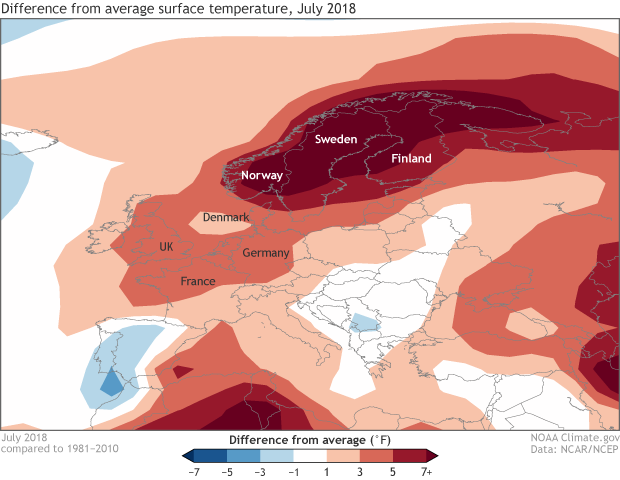New research examines climate change’s role in 2018 extreme weather events
Mud and flood debris blanketed a section of main street below an overpass in Ellicott City, Maryland, after flash flooding in late May 2018. Photo courtesy Howard County Government.
The desiccating Four Corners drought, intense heat waves on the Iberian peninsula and in northeast Asia, exceptional precipitation in the Mid-Atlantic states, and record-low sea ice in the Bering Sea were 2018 extreme weather events made more likely by human-caused climate change, according to new research published today in the Bulletin of the American Meteorological Society (BAMS).
The eighth edition of the report, Explaining Extreme Events in 2018 from a Climate Perspective, presents 21 new peer-reviewed analyses of extreme weather across five continents and one sea during 2018. It features the research of 121 scientists from 13 countries looking at both historical observations and model simulations to determine whether and by how much climate change may have influenced particular extreme events.
The NASA satellite image from January 31, 2018, shows the western half of the Bering Sea free of ice, part of a historic record-low winter ice extent (graph at lower left) across the region. Human-caused warming was an "overwhelmingly likely contributor," according to the Explaining Extreme Events report, and such lows will likely be typical in 20-30 years. NOAA Climate.gov image based on Worldview imagery and data provided by Rick Thoman.
“We've now published more than 100 of these attribution studies in this AMS series and can see how powerful this science is getting,” said Jeff Rosenfeld, editor in chief of BAMS. “Attribution studies increasingly yield useful, nuanced conclusions that embrace real-world complexity. They collectively make an ever starker statement about the human influence on extreme weather.”
Stephanie Herring, a NOAA climate scientist and editor of Explaining Extreme Events, said that as the field of climate attribution matures, the scientific tools available to identify a climate signal in extreme weather events continue to grow.
“This year we are also seeing mounting evidence for our ability to identify a climate change signal in different types of extreme weather events, especially for forest fires and precipitation,” said Herring.
Here are some findings from research on 2018’s extreme weather published in this issue.
Heat
- In the past 40 years, there have been only two heatwaves comparable to the extreme heat experienced by northeast Asia in 2018. By 2050, climate change will increase the frequency of similar heat waves to once every four years.
- The August 2018 heat wave in Spain and Portugal was the warmest since 2003. Climate change exacerbated this event, making it at least ~1°C (1.8°F) warmer than similar events since 1950-1983.
- Persistent nighttime heat waves like the one endured in northeast China during the summer of 2018 were expected to occur about once every 500 years in pre-industrial climate. Under climate change, similar events are expected to become up to eight times more frequent.
Difference from average surface temperatures across Europe during July 2018. Red colors reflect warmer than average conditions while blue colors indicate cooler than average conditions. During July, a long lasting heatwave impacted northern Europe leading to well above-average temperatures as far north as the Arctic Circle. Climate.gov image using data from NCEP/NCAR Reanalysis.
Cold
- The spate of extremely cold days endured by central England during March 2018 are six to 12 times less likely to occur in the future because of climate change.
Heavy precipitation & flooding
- The exceptional precipitation that contributed to devastating flooding in Mid-Atlantic states from May to September 2018 was calculated to be 1.5 times more likely due to climate change.
- Record rainfall totals in Japan during July 2018 were boosted by about 7 percent due to rapid regional warming driven by climate change.
- Climate change has reduced by about 47 percent the probability of persistent heavy summer rainfall in central western China similar to the extreme experienced in 2018. But the probability of a peak one-day deluge like this region experienced in summer 2018 has increased by up to 1.5 times in a human-altered climate.
Drought
- High temperature induced by climate change was found to have made the Four Corners drought worse by reducing moisture in March snowpack by 20 percent and accelerating loss of soil moisture.
- The record-long dry period over Beijing during winter 2017-2018 was primarily driven by conditions influenced by La Nina and a weak Arctic polar vortex. Long-term climate change played a relatively small role.
Fires
- High temperatures driven by climate change helped establish conditions that contributed to the extreme fires in northeast Australia in 2018.
Sea ice
- Human-caused climate change was overwhelmingly likely to have contributed to the record low 2018 Bering Sea ice extent, which had profound regional impacts. Such low sea ice levels will likely be typical by the 2040s.
The extreme weather events studied in the eight annual issues of the report were selected by individual researchers and do not represent a comprehensive analysis of events during that span. About 73 percent of the 168 research findings published in this series identified a substantial link between an extreme event and climate change; about 27 percent did not.
Read the full Explaining Extreme Events report.




